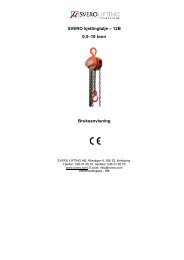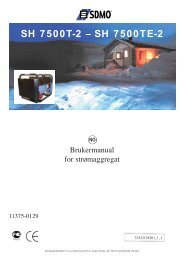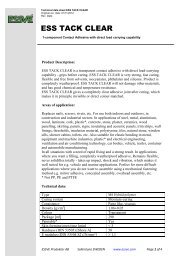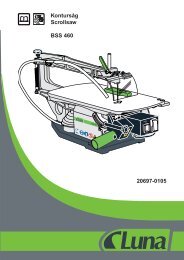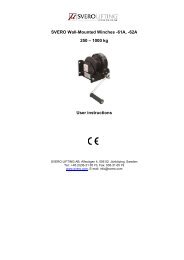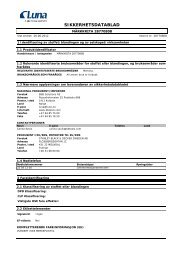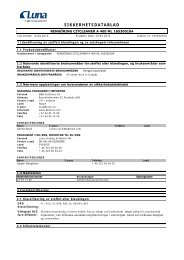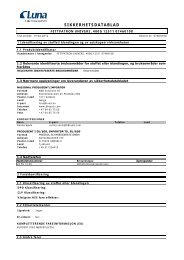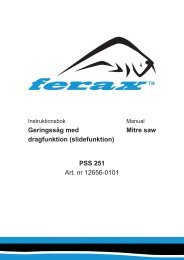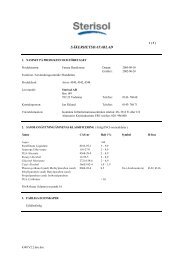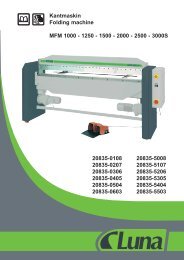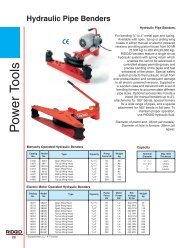Bandslipmaskin Belt Grinding Machine BBD 150 20645-0108
Bandslipmaskin Belt Grinding Machine BBD 150 20645-0108
Bandslipmaskin Belt Grinding Machine BBD 150 20645-0108
You also want an ePaper? Increase the reach of your titles
YUMPU automatically turns print PDFs into web optimized ePapers that Google loves.
19. CHECK DAMAGED PARTS. Before further use of the tool,<br />
a guard or other part that is damaged should be checked to<br />
assure that it will operate properly and perform its intended<br />
function-check for alignment of moving parts, binding of<br />
moving parts, breakage of parts, mounting, and any other conditions<br />
that may affect its operation. A guard or other part that<br />
is damaged should be properly repaired or replaced.<br />
SAFETY INSTRUCTIONS FOR BELT & DISC<br />
SANDER<br />
1. Sander must be bolted down to a stand or workbench for stability.<br />
2. Make sure there are no nails or foreign objects in the part of<br />
the workpiece to be sanded.<br />
3. Plan your work to avoid THROWBACKS - if the workpiece<br />
catches on the sanding belt or disc and is torn from your hand.<br />
4. Make sure there is no debris between the workpiece and its<br />
supports.<br />
5. When sanding irregularly shaped workpieces, plan your work<br />
support so it will not slip and be pulled from your hands.<br />
6. Use extra caution with large, very small or awkward workpieces.<br />
7. Never use this tool to finish pieces too small to hold by hand.<br />
8. Use extra supports (tables, saw horses, work stands, etc.) for<br />
any workpieces large enough to tip when not held down to the<br />
table stop.<br />
9. DO NOT use another person as a substitute for a table extension,<br />
or as additional support for a workpiece that is longer or<br />
wider than the basic sander table, or to help feed, support, or<br />
pull the workpiece.<br />
10. When finishing on the disc, always press the work piece<br />
against the “Down” side of the disc. Sanding against the side<br />
coming up from under the table could damage the work by<br />
making it “chatter”, or tear the work from your hands and<br />
throw it.<br />
11. Sand only one workpiece at a time.<br />
12. Find and read the WARNING label (see sample on right)<br />
mounted on the sander.<br />
13. Clear everything except the work piece and related support<br />
devices off the table before turning the sander on.<br />
14. Plan the way you will hold the work piece from start to finish.<br />
15. Avoid awkward operations and hand positions where a sudden<br />
slip could cause fingers or hand to move into a sanding surface.<br />
Keep fingers away from where the belt goes into the dust<br />
trap.<br />
16. Keep your face and body to one side, out of line with a possible<br />
throwback.<br />
17. Before starting work, watch the sander while it runs. If it<br />
makes an unfamiliar noise or vibrates a lot, stop immediately.<br />
Press the STOP button on sander. Unplug the sander. Do not<br />
restart until finding and correcting the problem.<br />
18. DO NOT FORCE TOOL. Press the work piece against the<br />
sanding material only hard enought to let it sand without bogging<br />
down or binding.<br />
19. Before freeing any jammed material ensure that you follow<br />
the next three steps.<br />
• Press the red “STOP” button.<br />
• Unplug the sander from the mains power supply.<br />
• Wait for all moving parts to stop.<br />
20. WARNING LABELS – It is important that labels bearing<br />
Health & Safety Warnings are not removed or painted over.<br />
New labels are available from Customer Services.<br />
21. MECHANICAL SAFETY – The security of all clamps and<br />
work holding devices should be checked before switching on.<br />
22. WOOD DUST – The fine particles of dust produced in sanding<br />
operations can be a long term health hazard if excessive.<br />
38<br />
Some imported hardwoods do give off highly irritant dust<br />
which causes a burning sensation. We strongly recommend the<br />
use of a dust collector and dust mask/visor. Our Custeromer<br />
Seervices will be happy to advise you on the correct unit for<br />
your needs.<br />
BEFORE EACH USE<br />
Inspect your sander<br />
Disconnet the sander. To avoid injury from accidental starting<br />
unplug the sander before chaning the setup, sanding disc or belt or<br />
adjusting anything.<br />
Check damaged parts. Check for:<br />
• alignment of moving parts<br />
• binding or moving parts<br />
• broken parts<br />
• work parts that cause a gap larger than 1/16” between work support<br />
and sanding surface.<br />
• sanding belt narrower than 6 inches. Narrower belts uncover<br />
parts that could trap your fingers.<br />
• worn or damaged electric cords<br />
• stable mounting and<br />
• any other conditions that may affect the way the sander works.<br />
In any part is missing, bent, or broken in any way, or any electrical<br />
parts don’t work properly, turn the sander off and unplugg the<br />
sander. REPLACE damaged, missing, or failed parts before using<br />
the sander again.<br />
MAINTAIN TOOLS WITH CARE. Keep the sander clean for<br />
best and safer performance. Follow instructions for lubricating.<br />
To avoid injury from jams, slips or thrown pieces:<br />
• USE ONLY RECOMMENDED ACCESSORIES. Consult<br />
this owner’s manual for recommended accessories. Follow the<br />
instructions that come with the accessories. The use of improper<br />
accessories may cause risk of injury to person<br />
• Adjust any work support to clear the sanding surface by no<br />
more than 1/16”. When checking clearance between the belt<br />
and work support, press the belt that against the metal beneath<br />
it.<br />
• Make sure all clamps and locks are tight and no parts have<br />
excessive play.<br />
• Keep work area clean. Cluttered areas and benches invite accident.<br />
Floormust not be slippery.<br />
• To avoid burns or other fire damage, Never use the sander near<br />
flammable liquids, vaports or gases.<br />
PLAN AHEAD TO PROTECT YOUR EYES, HANDS,<br />
FACE, EARS.<br />
KNOW YOUR SANDER. Read and understand the owner’s<br />
manual and labels affixed to the tool. Lean its application and limitations<br />
as well as the specific potential hazards peculiar to the tool:<br />
To avoid injury from accidental contact with moving parts.<br />
• KEEP GUARDS IN PLACE and in working order.<br />
• Don’t do layout, assembly, or setup work on the sander while<br />
any parts are moving.<br />
PLAN YOUR WORK<br />
USE THE RIGHT TOOL. Don’t before tool or attachment to do<br />
a job it was not designed to do.<br />
CUATION: This machine is not designed for heavy deburring<br />
operations. When finishing metal, sparks or hot fragments<br />
could cause a fire. To avoid this:<br />
• Disconnect any dust collecting hose from the sander<br />
• Remove all traces of wood dust from inside the sander<br />
• Remove all traces of metal dust from inside the sander before<br />
sanding wood again.



